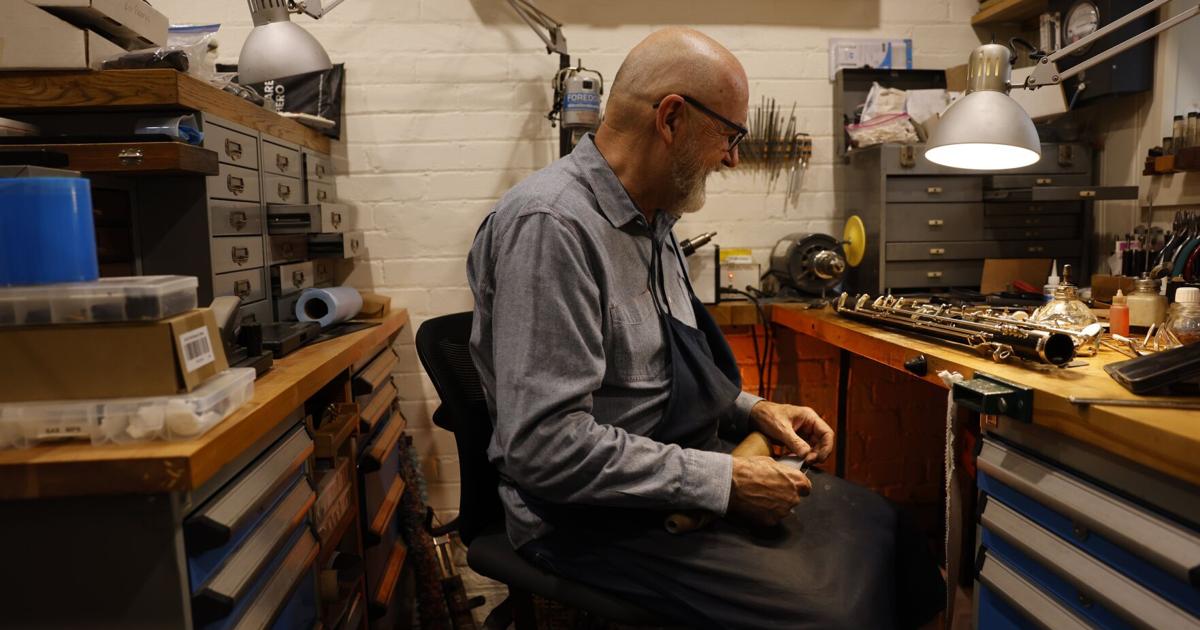Late one morning this fall, a man arrived at the workshop behind John Weir’s Toronto home, carrying an unusual, humidity-controlled case.
Weir, sitting at his workbench, knew who it was right away. The man was one of the finest clarinet players in the country. He opened his case and handed Weir a B-flat clarinet, joint by joint, which had been made by the world-class Buffet Crampon company in Paris.
“I’m having terrible water problems,” said the clarinetist, Kimball Sykes. “I don’t know what can be done.”
Sykes had concerts coming up with the National Arts Centre Orchestra, where he holds the coveted position of principal clarinetist. That morning, he travelled to Toronto from Ottawa for this appointment.
Weir turned the clarinet over in his hands. “Yeah,” he said, vacantly, as if he’d already given his mind over to the task.
At 71 years old, Weir has spent the past 50 years working on clarinets and saxophones for professionals from top orchestras, jazz outfits, schools and military bands across North America. He’s one of the few experts in the country who a top clarinetist like Sykes would trust with his instrument.
In the workshop off Danforth Ave., Weir set to work. It was a semi-annual tune-up for Sykes, tightening the mechanics, replacing and reshaping bits of cork, making sure the pads on the metal keys sealed when they met the wooden tone holes. He took a piece of paraffin wax, set it on the tip of a palette knife, and hovered it over an old glass Bunsen burner.
Once the wax melted, he ran the palette knife over a piece of cork, sealing it with the wax. He used a syringe filled with red oil to lubricate the keys, but refused to say exactly what kind of oil it was.
“It’s actually proprietary,” he said, hunched over his workbench. He has a deep, lyrical way of speaking, like O’Malley the alley cat.
After about an hour, Weir turned to Sykes’ water issue. The problem started with hot breath. Moisture in the breath condenses inside the instrument and can flow to the wrong place.
“You’ll get this gurgling sound,” Sykes said.
Over time, the water will establish a track, funnelling moisture to the same spot. Untreated, the gurgling never stops.
“It’s very disturbing,” Sykes said.
“I think I’m going to run some oil through the upper joint,” Weir told him. “Just to see if we can get the water to carry on down the horn.”
It sounded like a tossed-off idea, but the oil trick was part of Weir’s tested playbook to combat gurgling. He’s been fixing clarinets and saxophones since around 1975 and at one point manufactured instruments as well, including his own line of clarinets. In the 1980s, he became a go-to repairman for a group of famous jazz musicians in Toronto, including the saxophonist Pat LaBarbera.
Canadian jazz legend Moe Koffman once advised Weir to become “a proven guy” in the industry — and that’s more or less what happened. Major jazz acts passing through Toronto ended up knocking on the door of his shop for emergency repairs, including Zoot Sims, Bob Berg, Lee Konitz and Wayne Shorter.
“Doing this gets you into a very cool club,” Weir said.
Over the past 20 years or so, Weir and his wife, the accomplished clarinetist Patti Goodwin, ran a clarinet sales and repair business out of a shop on the Danforth. The storefront is gone now and the business is nearly done. Weir just can’t stop doing repairs. (He also books jazz shows for Hirut Cafe, an Ethiopian restaurant in his neighbourhood.)
His 200-square-foot workshop, in his backyard, is cluttered with machinery, tiny drawers for instrument parts, plastic bins holding clarinet barrels, and on the floor, a lineup of instruments in their cases, mostly belonging to professionals in orchestras from around the province, all waiting for Weir’s attention.
“I’m having trouble saying no,” he said. “But at the same time, I’m 71 and I need to uncross my eyes a little bit.”
As Weir was working on Sykes’ B-flat clarinet, there was another knock at the door. It was a 26-year-old clarinetist from California named Johnny Wang. He won a spot with the Toronto Symphony Orchestra this year. He auditioned in a preliminary round, then semifinals and finals. Each time, he performed behind a curtain so the judges didn’t know who was playing. The orchestra rolled out a carpet to muffle the candidate’s footsteps, so the judges couldn’t make any deductions from the type of heel the performer wore.
Wang was in the process of breaking in two new Buffet clarinets, which Weir had helped him set up.
Wang knew Weir by reputation long before he actually met him. When Wang was studying at the San Francisco Conservatory of Music, his professor talked about this guy in Toronto who made his own aftermarket clarinet parts, specifically barrels. Wang started buying them. After school, he played in orchestras around the U.S., and would have to take a five-hour train ride just to find to a decent clarinet repair technician. In Toronto, Weir was within walking distance.
“So have you played your horns?” Weir asked Wang, gingerly.
A new clarinet’s first days are crucial. It must not be played too little or too much, so the wood can acclimatize. But Wang was in the middle of the symphony’s gruelling fall schedule and didn’t have much time.
“Try and keep at them steady,” Weir instructed.
“I’ll do my best,” Wang said.
Weir smiled. “That’s the right answer.”
Neither of the men said it out loud, but Wang’s new clarinets were in danger. If a clarinet is going to crack — about half of them do, by Weir’s estimation — it is most likely to happen within the first year.
After Wang left, Weir traced his finger along a faint scar on Sykes’ B-flat clarinet.
“This instrument is cracked,” he said. “You can see where I pinned it.”
After the crack, Weir drilled little holes around the fracture, then sewed it shut with pieces of threaded rod.
Sykes remembered the ordeal sombrely.
The instrument, made of granadillo wood, retails for about $13,500. In orchestras, clarinet players usually rely on two main instruments, one in B-flat, which is often the workhorse, and another in A.
“If I play a few more years, I’m not sure the B-flat is going to make it,” Sykes confessed to Weir. “It’s starting to feel like it’s changing.”
Clarinets are not like violins. They do not last for centuries. The swings from hot to cold, humid to dry, eventually catch up with the wood. When a clarinet dies, it’s sometimes referred to as being blown out. Weir has spent his life so close to that truth, watching beautiful things fall apart, that he thinks of his legacy as something occurring right now, in the present, in someone’s hands.
“You’re kind of catching a moment,” he said, “and doing the best possible thing you can with that moment.”
That morning in the workshop, Weir finished his work and handed the clarinet back to Sykes.
Sykes took out a reed, rolled it around in his mouth, fixed it to the clarinet, then started playing excerpts from Weber, Mozart and Kodály, including “Dances of Galánta,” which his orchestra was performing the next week.
As he played, his face changed. The muscles that had been dormant in the cheeks and chin were now flexed and the blood was rushing up. Suddenly, it became clear that this ordinary-looking man, who had been making quiet conversation for more than an hour, possessed a secret, exquisite magic.
He stopped playing and was silent for a moment.
“It feels a bit tighter,” Sykes said.
“Yeah,” Weir agreed.
With nothing left to do, he turned his attention to the next clarinet.
Cool Jobs is a regular series of profiles of Toronto-area residents who have mastered uncommon and noteworthy professions.



